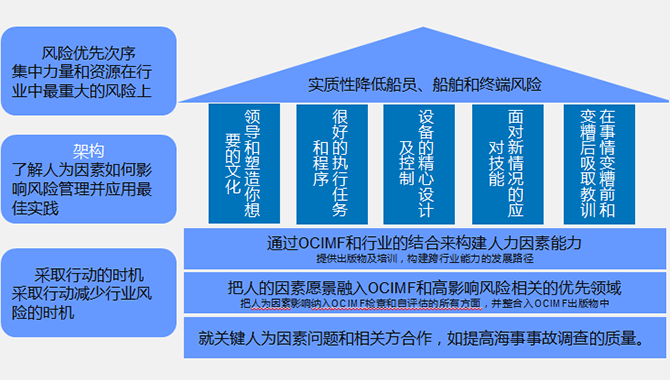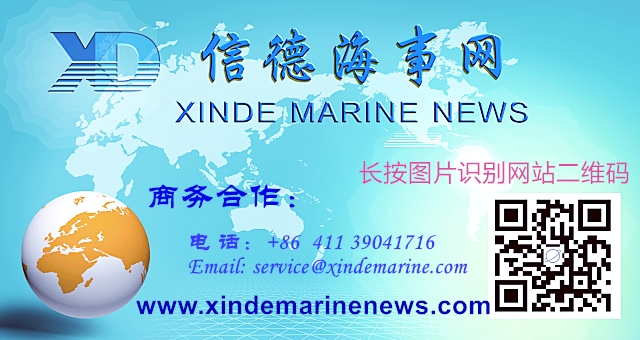背景:OCIMF最新发布TMSA-人为因素之人为因素方法。目的是如何从本质上构建减少海上风险的架构,最终实现把人为因素纳入所有程序及活动的目标。
OCIMF的使命和愿景
使命:领导全球航运业发展,促进原油、成品油、石化产品和天然气的安全、环保运输,并推动相关海洋作业的管理。为此,我们在设计、建造和安全操作油轮、驳船和近海船舶以及它们与码头的界面方面制定了最佳实践,并在OCIMF所涉及的一切工作中考虑人为因素影响。
愿景:建立对人类和环境无害的全球航运业。
1. Introduction
介绍
There have been reductions in the number and severity of marine incidents in the past few decades. This can be partly attributed to improved design of equipment, improved safety management systems, improved regulations and best practices. OCIMF aspires to achieve further improvement in safety and environmental protection in the marine industryby considering human factors in everything we do.
▲在过去几十年里,海上事故的数量和严重程度都有所减少。这可以部分归因于改进了设备的设计、改进了安全管理系统、改进了规章制度和最佳做法。OCIMF希望在我们所做的每一件事情中都考虑到人为因素,从而进一步改善海洋工业的安全和环境保护。
Thispurpose of this paper is to outline how OCIMF will integrate Human Factors into its activitiesand make progress on human factors in our industry.It includes:
▲本文的目的是简要描述OCIMF将如何把人的因素融入各种活动中,并在我们行业的人的因素方面取得进展。它包括:
• A set of principles that guide OCIMF’sactions on human factors
• An overall goal for OCIMF
• A framework to understand how human factors issues impact operations
• Opportunities to take action
OCIMF一套指导人为因素行动的原则
OCIMF的总体目标
一个了解人为因素如何影响操作的框架
采取行动的时机
2. About Human Factors
关于人为因素
Many industry sectors attribute human involvement to around 80% of incidents. This might give the impression that people cause incidents. However, 80-90% of the time it is found that mistakes, actions and decisions are themselves the result of the way the workplace is set up; how work is designed,equipment and control measures, and how leaders influence the culture in an organisation.
▲许多行业认为约80%的事故是人为因素造成的。这可能会造成所有事故都人为因素的印象。然而,80% -90%的情况下,人们发现错误、行动和决定本身就是工作场所建立方式的结果;如何设计工作、设备和控制措施,以及领导者如何影响组织中的文化。
Human factors are the physical, psychological and social characteristics that affect human interaction with plant and processes.
▲人为因素是影响人类的生理、心理和社会特征与设备相互作用的过程
It is the people on our ships and in our operations and support teams who make safety work. However, human error still occurs as a result of humans interacting with latent conditionsand unhelpful systems . When we tackle these, we can reduceincidents and improve reliability and productivity.
▲是我们的船员及操作和支持团队,共同铸就作业安全的人。然而,由于人与潜在的问题和无用的系统交互作用,人为错误仍然会发生。当我们处理这些问题时,我们可以减少事故,提高可靠性和生产力。
3. Guiding Principles
指导原则
These principles describe our approach to human factors, and are based on those from oil and gas, aviation and nuclear industries. . We use the principles as a simple script to talk about human factors, and as aguide for the improvements we make in OCIMF activities.
▲这些原则描述了我们处理人为因素的方法,并以石油和天然气、航空和核工业为基础。我们将这些原则作为讨论人为因素的简单脚本,并将其作为改进OCIMF活动的指南。
People will make mistakes
▲人会犯错
People’s actions are rarely malicious and usually make sense to them at the time
▲人们很少有行为恶意,所做的一切通常在当时对他们来说是有意义的
Mistakes are typically due to conditions and systems that make work difficult
▲通常是由于条件和系统使工作变得困难而出现典型的错误
Understanding the conditions in which mistakes happen helps us prevent or correct them
▲了解错误发生的条件有助于我们预防或纠正错误
People know the most about their work and are key to any solution
▲让人们最大限度了解他们的工作时解决问题的关键所在
Plant, tools and activities can be designed to reduce mistakes and manage risk better
▲可以通过对设备、工具和活动内容设计来减少错误和更好地管理风险
Leaders help shape the conditions that influence what people do
▲领导者帮助塑造影响人们行为的环境
It matters how leaders respond when things go wrong. Take the opportunity to learn
▲当事情出错时,领导者如何应对至关重要。抓住机会学习
4. TheStrategy
▲策略
Our goal
▲我们目标
Our goal is to materially reduce risk to crew, ships and terminals, by systemically addressing the systems and latent conditions that influence errors, actions and decisions.
▲我们的目标是通过系统性地解决影响错误、行动和决策的系统和潜在条件,实质性地降低船员、船舶和码头的风险。
OurStrategy
▲我们的策略

Our plan
▲我们的计划
Ourapproachconsists of three key elements, i.e.risk priorities, a framework for understanding the impact ofhuman factors onrisk management and opportunities for action.
▲我们的方法包括三个关键要素,即风险优先次序、了解人为因素对风险管理的影响的框架和采取行动的时机
Risk priorities: we will focus our efforts and resources on the most significant risks in the industry as defined by OCIMF e.g. loss of primary containment, fatality/serious injury.
▲风险优先级:我们将集中力量和资源用在OCIMF所定义的行业中最重大的风险上,例如,主要保护控制措施丧失、致命/严重伤害。
Framework: we will understand how human factors effects risk managementthrough the five pillarsof human factors that are relevant to the marine industry. The pillars will be used as the basic structure to:
▲架构:我们将通过与航运业相关的人为因素的五根柱子来了解人为因素如何影响风险管理。这些柱子将作为结构的基本组件
• Provide Operators (and others) with processes and guidanceallowing them toanalyse and develop controls for their own situation
▲为经营人(和其他人)提供指导流程,使他们能够针对自己情况分析和开发控制方案
• Analyse accidents and data tounderstandthe human factors issuesand latent conditions that contribute to failureof a pillar
▲分析事故和数据,以了解导致支柱倒下的的人为因素问题和潜在的条件
• Identify and recommendgood practice to prevent or mitigate any failureof a pillar
▲识别并推荐良好实践,以预防或减少支柱的任何缺陷
• Explain and educatehuman factors issues
▲解释及培训人为因素的问题
The following are some example topics under the pillars of the framework:
▲以下是框架支柱主题的一些示例:
Example topics falling under this pillar
▲支柱下的典型示例
Leading and shaping the culture you want
▲领导和塑造你想要的文化 •
The role of latent and organisational conditions in accidents
▲在事故中潜在和组织条件的作用
• How leadership shapes culture
▲如何用领导力塑造文化
• Diverse cultures
▲多元文化
• Industry-wide culture
▲行业文化
• Workplace influence on crewwell being
▲工作场所对船员健康的影响
• People as a solution, not a problem
▲人,作为问题解决者,本身不是问题
• Listening to the workforce
▲倾听员工心声
• Responding when things go wrong
▲当事情朝坏的方向发展时做出反应
Well-executed tasks and procedures
▲执行良好的任务和程序
• Designing tasks to reduce error
▲通过任务设计减少错误
• Effective control of work
▲对工作有效控制
• Effective procedures
▲有效的程序
• The effectiveness of regulations
▲规则的有效性
• Training and skill building
▲培训及技能的积累
• Work as we imagine it, and as it really is
▲按我们想象的去做,按实际情况来做
• Taking human factors into account in risk assessments
▲在风险评估中考虑人为因素
• Manning and Workload management
▲人员配备和工作负荷管理
• Selection and capability
▲选择及能力
• Fatigue
▲疲劳
Well-designed Equipment and controls
▲精心设计的设备和控制
• Human–centred design of bridge, engine room, cargo, deck and terminal equipment
▲以人为本的驾驶台、机舱、货物、甲板及终端设计
• Human-machine interfaces
▲人机界面
• The impact of automation and increased complexity
▲自动化影响和复杂性的增加
Skills to respond to emerging situations
▲新兴情况下的技能应对
• Building bridge, engine room and crew skills
▲驾驶台、机舱及船员技能积累
• Situationalawareness and recovery
▲态势感知及复原
• Team communications
▲团队联系
Learning before and after things go wrong
▲在事情变糟前、后学习
• Effective human factors Investigation
▲有效的人为因素调查
• Learning from the people who do the task,to get ahead of incidents
▲向那些完成任务的和走在事故前面的人学习
Opportunities for action: we will take the followingstrategic actionson human factors to reduce risk in the marine industry:
▲行动的时机:为减少航运业风险,我们将采取以下有关人为因素的行动策略
1. Capability: we will aim to build human factors capability in OCIMF and the industry by a combination of:
▲能力:我们的目标是通过与OCIMF和行业的结合来构建人力因素能力
• Providing publications and training
▲提供出版物及培训
• A development pathway to build capability across the industry
▲构建跨行业能力的发展路径
2. Integration:we will build human factors perspectives into OCIMF’s high impact risk-related priority areas such as:
▲集成:我们将把人的因素愿景融入OCIMF与高影响风险相关的优先领域,例如
• Programmes: integrating human factors in all aspects of OCIMF inspection and self assessment programmes,e.g. SIRE, OVID and TMSA
▲程序:将人为因素纳入OCIMF检查和自我评估项目的所有方面,如SIRE、OVID和TMSA
Advocacy: we will engage and collaborate with IMO and other industry organisations, institutions and regulatory bodies on key human factors issues, e.g.improving quality of marine incident investigations
▲倡导:我们将与国际海事组织和其他行业组织、机构和监管机构就关键的人为因素问题开展合作,例如提高海事事件调查的质量
编译:傅恒星 赵翔
免责声明:本文仅代表作者个人观点,与信德海事网无关。其原创性以及文中陈述文字内容和图片未经本站证实,对本文以及其中全部或者部分内容文字、图片的真实性、完整性、及时性本站不作任何保证或承诺,请读者仅作参考,并请自行核实相关内容。
投稿或联系信德海事:
media@xindemarine.com

09-03 来源:信德海事网
05-18 来源: 中国船检
10-12 来源:傅恒星 中国船检
06-20 来源:信德海事网
02-06 来源:信德海事网
05-06 来源:招商南油 傅恒星
04-09 来源:信德海事网
05-07 来源: 傅恒星
01-09 来源:中国船检
11-22 来源:信德海事网